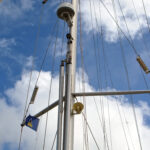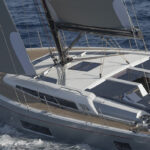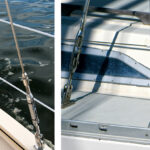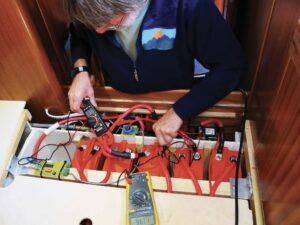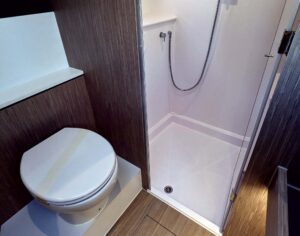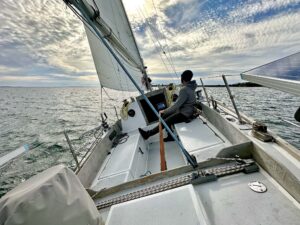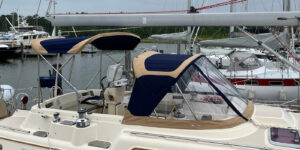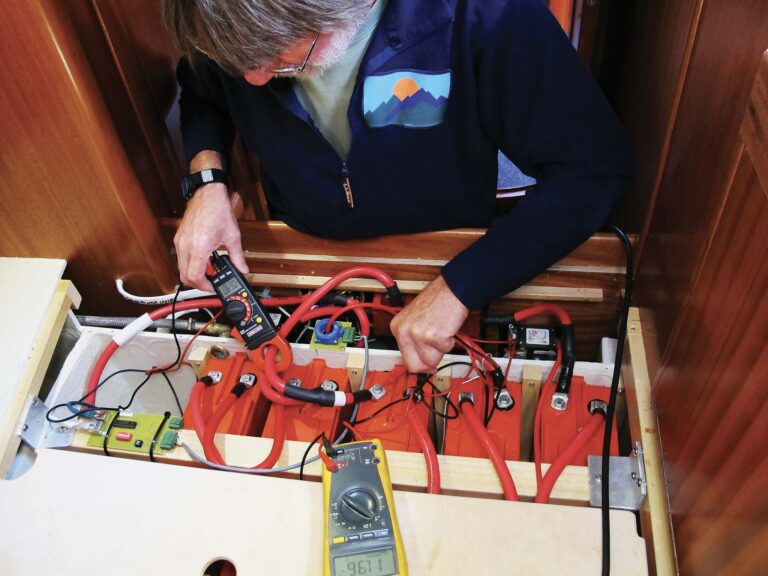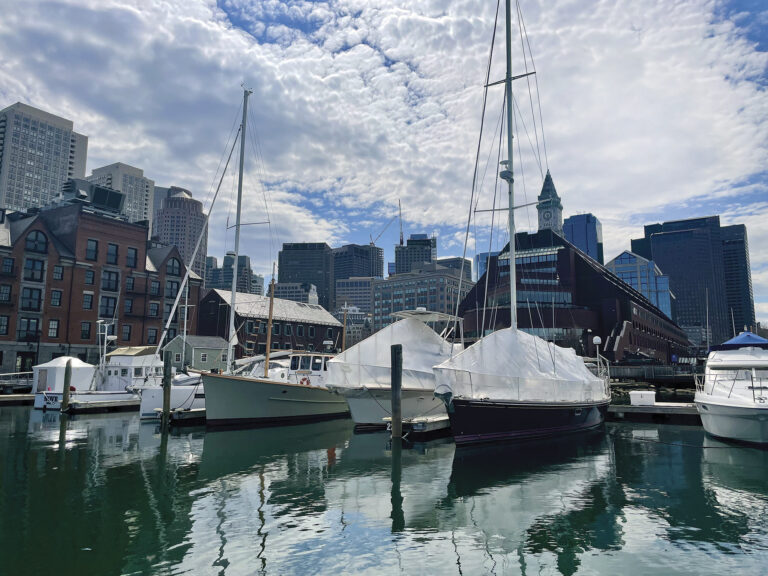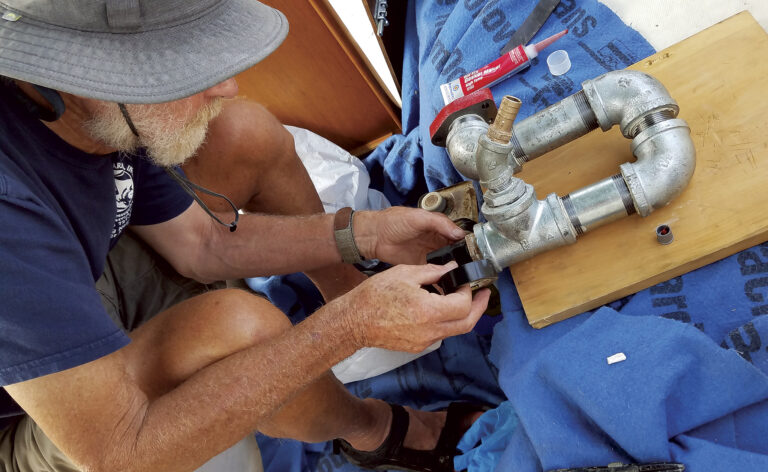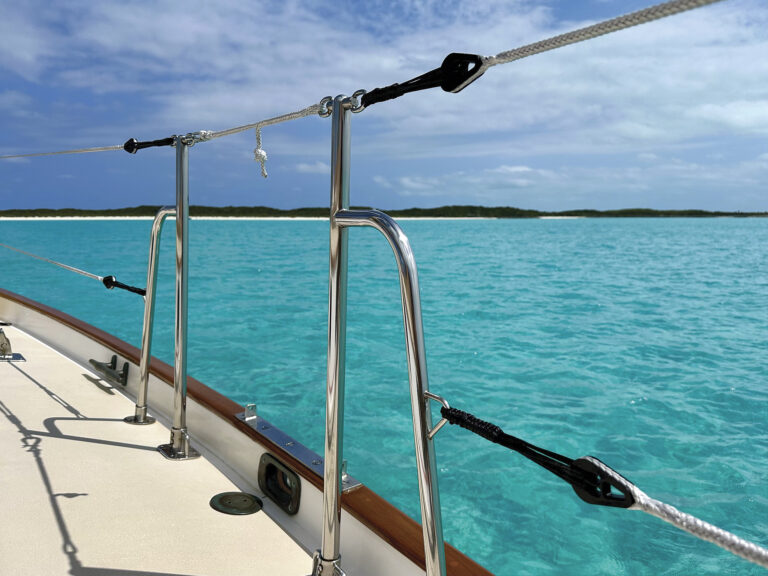
I pretty much took rigs for granted when I first started sailing on other people’s boats. After all, unlike exciting, moving, tweakable things like sails and running rigging, masts and booms were just there—a part of the structure of the boat. I took no part in their maintenance or tuning. So as long as they kept the sails out of the water, all was well.
It wasn’t till I got my first sailboat that I started paying more attention to my own spars and standing rigging. And it wasn’t until I had to order a replacement rig for my 1973 Norlin 34 many years ago that I truly began to understand the sparmaker’s and rigger’s jargon. By far the most common configuration these days is the sloop rig with aluminum spars, so that’s what we’ll talk about here.
MASTHEAD/FRACTIONAL
Once upon a time, there was a clear separation between these two types of rig. A masthead rig had its forestay pinned to the top of the mast and had straight spreaders. If the boat was designed to a racing rule (as most were), it had large overlapping headsails and a tall, skinny main. A boat with a fractional rig, on the other hand, had its forestay attached 3/4 to 7/8 of the distance from the cabintop to masthead, had well-swept spreaders, carried a larger mainsail and smaller jib, and had a spar that was designed to be tweaked with adjustable backstay tension. Hence, for many years they were commonly found on racer-cruisers rather than pure cruising boats.

A weakness with the traditional fractional rig is that it is not easy to maintain adequate forestay tension in strong winds, since the forestay is not directly opposed by the backstay. On the other hand, many fractional boats sail well under mainsail alone, which is a good thing, since the large main tends to blanket the smaller jib when sailing downwind. The ultimate iteration of the cruising fractional rig is the Bergstrom & Ridder (B&R) rig, which does away with the backstay altogether. Instead, it employs a complex of reverse diagonal shrouds, as seen on many Hunter sloops over the years.
Nowadays, the difference between masthead and fractional rigs has been blurred. The reason for this is that the rig for many of today’s production boats is a not-quite-masthead 19/20ths rig, with large mainsails, well-swept spreaders and non-overlapping jibs that are self-tacking or sheet inside the shrouds. Because the forestay is set close to the masthead, tension is much easier to maintain. These kinds of boats often carry masthead A-sails or Code 0s downwind.
Among the advantages of a traditional masthead rig are that it is generally easier for a capable owner to tune. Its large overlapping headsails, while harder to handle for a small crew, can also in many conditions provide rewarding sailing when used without a mainsail. Beware, though, that pounding into a head sea without the counteracting pressure from a heavily sheeted main, is not good for the rig and could result in the mast “inverting”—bending backward in the middle, possibly leading to a dismasting.

DECK-STEPPED/KEEL-STEPPED
The main issue with a keel-stepped mast is that it requires a large hole to be cut in your deck or cabintop, and sooner or later that hole will leak. I have owned three boats with keel-stepped masts, and each one has suffered from water ingress around the partners or from inside the spar itself. They are also great transmitters of halyard slap and exterior cold.
Leaks aside, keel-stepped masts have long been regarded as the gold standard for offshore work, on the basis that should a major stay or shroud fail, they will usually break at the lower spreaders and leave at least a stump of mast standing as a base for a jury rig.
Because the mast step is built into the structure of the hull, it also provides a very strong base for compression loads. Such a mast can also stand unsupported by shrouds, a useful feature for tuning and other work, and is resistant to buckling. This, in turn, means you can sometimes reduce the mast-section size and/or forego the use of things like inner forestays and checkstays. On the downside, stepping and unstepping requires a tall crane with a skilled operator since it’s easy to damage the spar, the deck or interior furnishings when lowering the mast into the boat.
As it is, the majority of boats these days have deck-stepped rigs, which are largely leak-free. These are typically supported by a compression post that transfers the rig loads to the hull and takes up much less room down below than a typical mast section (which can significantly interfere with the saloon layout).
Unfortunately, while the mast step is outside the boat, you will still have some holes in your deck, as the various electrical and electronics cables must pass through. Some poorly built older boats have also suffered from deck compression around the mast base, although with modern build practices this is now less of a problem. Take it from the thousands of boats that have circumnavigated under deck-stepped rigs that they are entirely suitable for just about any kind of sailing.
MAST AND BOOM SECTIONS
When specifying spar and boom sections, rig designers will calculate your boat’s righting moment according to its displacement, ballast ratio, draft and beam, and then size accordingly. The thickness of the mast wall, the number and location of the halyard exits, and the longitudinal and lateral dimensions are all taken into account.
A rig designer will also work to the boat’s intended use and sailing conditions: a boat used for weekending and round-the-cans racing in a light-airs region, for example, may be able to get away with a lighter section and lighter standing rigging than a boat that sails in high-wind areas or will be taken across oceans.
Almost all mast sections these days are oval, as the heaviest loads on the rig are from the forestay and backstay. Rig designers work hard to balance lightness and strength since unnecessary weight costs money and affects ultimate stability and performance.

MAST SUPPORT
Standing rigging is the collective term for the system of wires (or rods) that supports the mast, both fore-and-aft and laterally. Lateral stays are known as shrouds and each has its own name (see diagram). The “shroud angle” is the angle between the mast and the cap shroud, typically never less than 12 degrees.
Spreaders hold the shrouds away from the mast, and their length and fore-and-aft angle are critical to stability. The uppermost spreaders, in particular, are also installed at a slight upward angle to bisect the angle the shrouds make as they are brought in toward the top of the mast or the hounds, the better to support the resulting compression load.
Cruising boat rigs can have up to three pairs of spreaders, depending on a number of factors, including the boat’s size and type. Rig designers will calculate the optimum length of the unsupported lengths, or “panels,” of the relevant mast section and locate the spreaders where they will provide the best support. Generally speaking, the more spreaders, the lighter the mast section can be. The spreaders themselves must be strong enough to withstand the compression loads of the shrouds, which can be considerable.
Swept-back spreaders are mandatory on modern fractional rigs and are now commonly seen on cruising monohulls with masthead rigs. Combined with a wide shroud base, they permit a lighter mast section to be used and make it easy to prebend the mast for stability, i.e., prevent the spar from inverting. On the other hand, they are seen as a nuisance by many sailors, who lament the fact the main can no longer be eased as far out as they’d like without bearing against the spreaders.
On keel-stepped rigs, the deck collar provides another support point, and coupled with an adjustable mast step can be used as a tuning aid to adjust rake (see Rig Tuning).

SHEETING ANGLES AND SHROUD BASES
No one wants a boat that won’t go to weather, even if you don’t intend to do so very often. This is why you see so many boats with headsail sheet tracks set as far inboard as possible, even on the cabintop. The angle between the boat’s centerline and a line drawn from the sail’s tack to its clew when sheeted in hard is the sheeting angle. This can be as tight as 7 degrees or less with a non-overlapping jib, or 10 degrees or more for an overlapping genoa that must be sheeted outside the shrouds. Rig design has an effect on sheeting angles.
Shroud base is the term for the distance between a boat’s chainplates. For a long time, rig designers used additional panels and/or ever-more-acute spreader rake to narrow their shroud bases so that the tracks for overlapping headsails could be brought farther inboard. More recently, however, as mainsails have grown larger and the trend toward smaller, often self-tacking headsails has flourished, the fashion has been to increase the shroud base right to the sides of the hull. This not only allows smaller headsails to be sheeted inside the shrouds, but offers a number of construction advantages. These include permitting a wider shroud angle between the cap shrouds and masthead, the ability to use lighter rigging wires and mast sections, and allowing the chainplates to be bolted directly to the hull’s topsides rather than a set of internal fixtures.
RIG TUNING
The goal of mast tuning is first and foremost to ensure the spar remains stable in both the longitudinal and lateral planes. You can check lateral tune by sighting up the sail track. If it curves to one side in the middle or at the top, then the mast is out of column and the standing rigging must be adjusted—first through static tuning dockside, then under sail. This procedure gets more complicated according to the number of spreaders and the type of rig. Fore-and-aft tune involves tweaking rake and prebend. Correct mast tuning is vital to getting the best performance out of your boat. There are many guides to tuning available online.
The spreaders on a masthead rig; note the slight upward angle, which bisects the angle of the shrouds
A pair of swept-back spreaders aboard a fractionally rig slooop
The genoa aboard this masthead sloop sheets outboard of the shrouds, which are slightly inboard
The narrow headsail aboard this fractionally rigged Beneteau Oceanis 51.1 sheets well inboard
An example of the complex system of shrouds found on multihull masts (left); An example of rod rigging (right).
An example of Norseman terminals; outboard chainplates are integrated into the hull structure (left); A pair of swaged shrouds terminates inboard (right).
RAKE/PREBEND
Mast rake involves sloping the mast aft from vertical by a few degrees and is one of the tools used to control weather helm, or a boat’s (very desirable) tendency to steer to windward when the helm is released. If the boat exhibits lee helm, i.e., it wants to turn downwind when you let go of the wheel, you can gradually increase mast rake to induce weather helm by easing off the forestay and taking up on the backstay. Typically, 1 or 2 degrees of rake is enough on a masthead rig. Fractional rigs are often raked 3 degrees or more.
According to Seldén Mast’s Scott Alexander, prebend is the most important factor in keeping a mast stable. To induce prebend, tension the backstay and take up on the forward lowers or babystay, and/or tension the cap shrouds if the spreaders are raked aft. The resulting forward curve will protect the mast against buckling in the middle, i.e., inversion. Prebend can be measured by taking the genoa halyard to the forward side of the mast at deck level. How much is too much? Seldén Mast designs its spars for a maximum longitudinal deflection of 2 percent of the foretriangle height.
MULTIHULL RIGS
The spectacular growth of multihulls in both the charter and private markets over the last 20 years has led to a “standard” rig configuration, the same as with production monohulls. Because the shroud base is the width of the hulls, the resulting fractional rigs are very well supported laterally, in some cases without the need for spreaders. Backstays can also typically be done away with, allowing for plenty of roach in the main. To cope with the greater rig loads found on multis, mast sections are beefier than on an equivalent-length monohull. They also require a healthy amount of pre-bend, which is locked in using a combination of diamond stays and/or cap shrouds and aft-swept spreaders, with the shrouds often terminating at various points on the mast itself.
STANDING RIGGING
Some higher-end performance boats and larger cruising yachts are fitted with rod rigging, which has a high strength-to-weight ratio and low windage on account of the smaller diameters that can be used. There has also been a small but growing shift in the aftermarket toward high-modulus fiber standing rigging, notably Dynex Dux, which offers even lower weight aloft along with ease of installation for the DIY boat owner. High-tech rigging is also now standard on high-performance multihulls. That said, the go-to option aboard most cruising boats and smaller racers and daysailers remains 1×19 stainless steel wire (wire comprised of 19 single strands). This has less stretch than the other types of wire “rope” found on boats, such as 7×7 (in which a single wire is comprised of seven smaller wires each comprised of seven strands) or 7×19 (in which the wire is comprised of seven smaller wires each comprised of 19 strands).
Rigging wires are terminated with either swaged fittings, which are squeezed onto the wire with special presses at a rigging shop, or mechanical fittings, like those made by Sta-Lok or Norseman, which are more expensive but are reusable and can be installed by a capable DIY-er.
SPAR STUDY
The deceptive simplicity of the typical sailboat rig can lead to a kind of benign neglect on the part of the boat owner. Since so many decades-old boats still sport their original rigs, the inherent toughness of aluminum spars and wire standing rigging encourages complacency—and complacency is dangerous on a sailing boat. Take the time to get to know your rig, and it’ll take you as far as you want to go.

RIG-SPEAK
Learning these terms will not only add to your standing in the yacht club bar, and they will also help you communicate more effectively with sailmakers and riggers.
Baby stays/Checkstays: Run to a point below the lower spreaders to provide additional mast support
Backstay: Stops the top of the mast from moving forward; tension can be changed to affect rig tune
Bury: The part of a keel-stepped mast between the hull and deck
Cap shrouds (A): Running from the masthead (on a masthead rig) or the hounds (on a fractional rig), these prevent lateral movement of the masthead and in a factional rig counteract the force of the forestay
Cutter Stay: Carries an inner headsail (jib or staysail)

Forestay: Stops the mast from moving backward and carries a headsail
Intermediate Shrouds (B): On multi-spreader rigs, these are affixed by the upper spreader base and taken over the lower spreader tips; they can terminate at the lower spreaders (in a linked rig) or be taken to the chainplates (in a continuous rig)
Lower Shrouds (C): Affixed to just below the lower spreader base, the fore and aft lowers stabilize the mast longitudinally
Partners: The hole in the deck where the mast passes through—now more commonly called a deck collar
Running backstays/Runners: These counteract the loads from a cutter stay and/or help stabilize the rig; they are often tensioned with a tackle
April 2020


